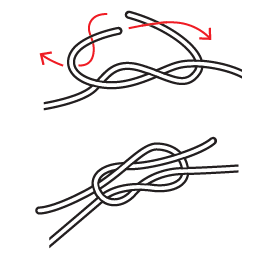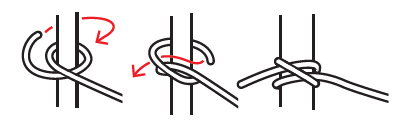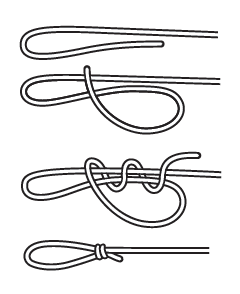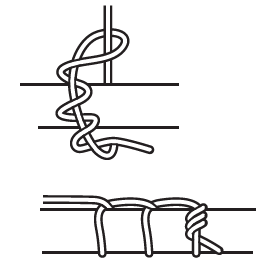ROPE IS AT ONCE ONE OF THE MOST USEFUL SURVIVAL TOOLS YOU CAN HAVE AND ALSO ONE OF THOSE THAT TAKES THE MOST PRACTICE TO PERFECT. IF YOU’RE LIKE MOST MODERN FOLKS, TYING YOUR SHOELACES IS AS CLOSE TO KNOT-TYING MERIT BADGE TERRITORY AS YOU’LL GET. BUT BUNNY EARS SIMPLY WON’T CUT IT IN THE WILD. A GOOD KNOT CAN SAVE A LIFE IN THE WILDERNESS, WHETHER IT’S PROTECTING YOU FROM WIND, WATER, A FALL OR WORKING AS A COMPONENT KEEPING YOUR SHELTER UP OR YOUR TRAPS FULL. FOR CLARITY, THE “WORKING END” OF A ROPE IS THE PORTION YOU’RE GOING TO BE LOOPING AROUND THINGS, WHILE THE “STANDING END” IS THE PORTION THAT LEADS TO THE REST OF THE ROPE.
SQUARE KNOT
A square knot is used to tie two lengths of rope together for extension or strength-enhancing purposes. Hold the ends of the ropes you wish to tie together. Pass one end over and then under the other. Repeat the motion and pull tight, the same as you would to tie a pair of boots—just remember to skip the loops.

Illustration by T.M. Detwiler
CLOVE HITCH
Also known as a double hitch, the clove hitch is a quick, temporary knot commonly used for securing a line on a post. Easily cast off when not in need, it won’t hold permanently but is great for short-term heavy lifting both literal and figurative. To make this knot, pass the end of the rope around a post. Continue over the standing end and around the pole a second time. Thread the end under itself and pull tight.

Illustration by T.M. Detwiler
SLIPKNOT
A slipknot, which gets its name because the simple knot can slide easily up and down a length of rope, is useful for creating an adjustable loop. A slipknot will add pressure around the object with a simple tug, and can be just as easily undone. Make a loop by doubling the rope back on itself. Pass one end of the rope back up, forming a figure eight. Wrap that same end around the double lines of rope a few times and pull tight. Slide the knot up or down to adjust the size of your loop.

Illustration by T.M. Detwiler
TIMBER HITCH
The Timber Hitch is useful for dragging logs and easily comes loose when you stop pulling on it. When building a longer-term shelter, it’s an important knot to know as it will save you time and energy better spent keeping yourself alive than untying knots. To make this knot, pass the working end of a rope around an object and take a turn around the standing end. Tuck the working end back around itself three times with the lay of the rope.

Illustration by T.M. Detwiler
This post was derived from “The Official Handybook for Men” by James Ellis. For more handy tips, you can purchase the book from our online store.


